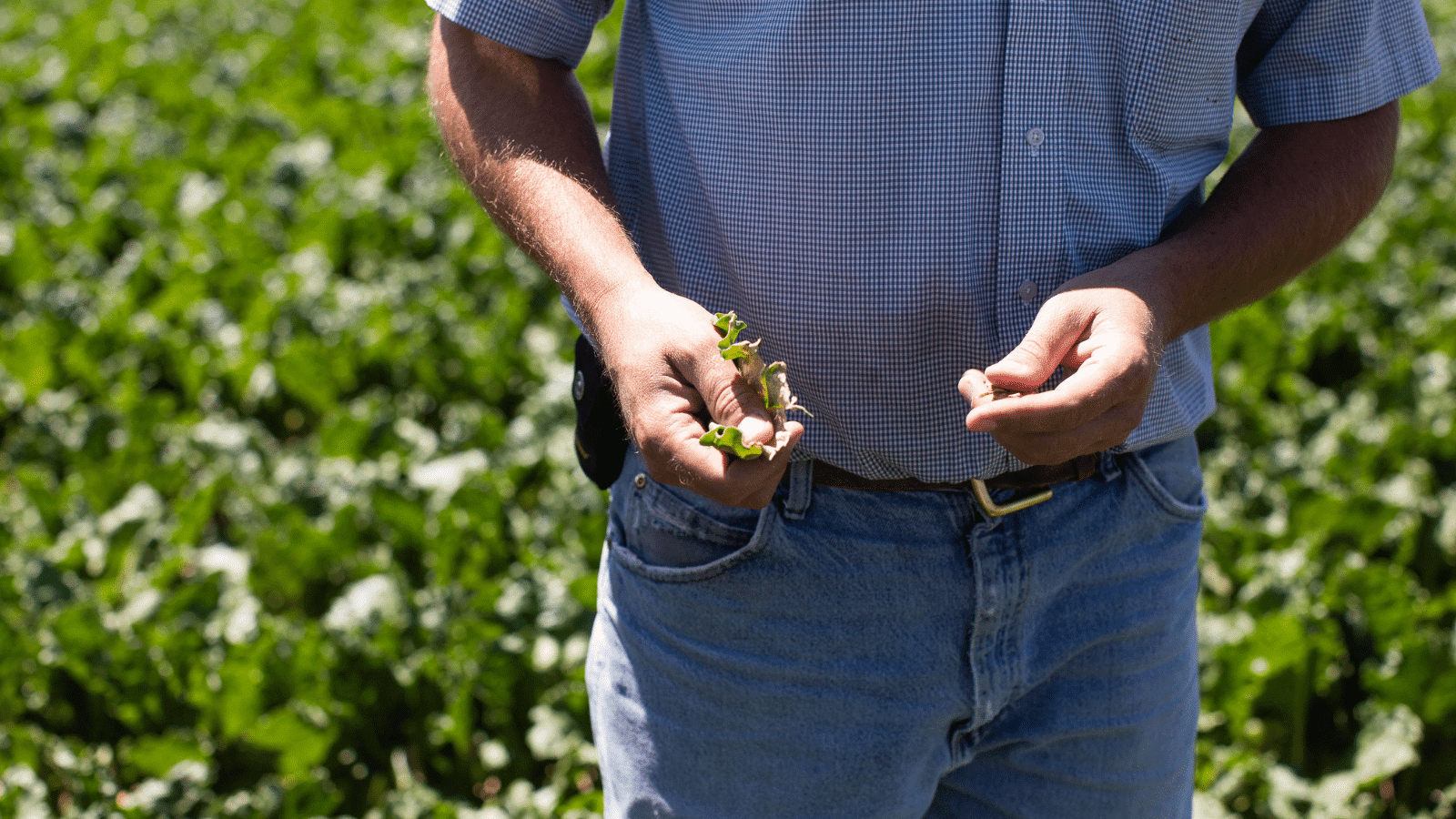In the fall of 2017 at the Annual Fall Agriculture Symposium, our Agricultural Department talked about “Being the Difference” in our occupations and with our Member Growers. Every year we are faced with field crop challenges; some can be foreseen while others occur randomly. As Growers, you have a huge investment in growing your crop and need to keep a close eye on your fields throughout the growing season. Crop scouting keeps you on top of field conditions, helps you catch problems early, and allows time for corrective actions to take place before major crop losses occur. “The Difference,” between having a below average crop and having an above average crop, is proper and timely field scouting.
An effective field scouting plan will give your crops the best opportunity to reach their full yield potential. Scouting fields throughout the growing season is essential to maximize yield and profitability. Scouting helps identify problems such as disease, pests, insects, weed pressure, and emergence issues. Identifying these issues is the first step in implementing management decisions. It is important to scout your fields in a timely manner and this means that scouting begins with crop emergence and ends with harvesting the crop. Field scouting is an economically sound prerequisite to pest management decision making. Regular scouting also prevents unnecessary treatments and reduces the uncertainty associated with management decisions.
Scouting
Scouting should be done weekly during the growing season, even daily when infestations approach economic levels, or weather conditions favor rapid development of specific pests or diseases. Signs and symptoms to look for are almost anything that appears abnormal. This can include stunted or off colored plants, chewed foliage, dead or missing plants, insect presence, weed escapes, abnormal plant growth, soil issues such as crusting or compaction, and a host of other indicators that something is not right. Sometimes it is environmental, like frost, hail or wind. The causes could be soil related rhizomania, Rhizoctonia, fertilizer burn or herbicide carryover. These could be nematodes, root aphid, root maggot, leaf-miner, black bean aphid, cutworm, or other insects. It could be foliar related Cercospora leaf spot, powdery mildew, chemical burn, or water stress. Diseases can be prevented and factors favoring disease development need to be monitored so timely action can be taken.
Early season scouting should be a high priority as this is when potential problems can be addressed before becoming real problems. Scout your fields! The front of your field may look great from the road, but your perceptions can change as you enter the field and take a closer look. Count the plant stands, starting with crop stand counts that equal 100 ft. of row. It is preferable to count the plant stands in multiple rows, like 5 rows of 20 ft. per row, thus equaling 100 ft. of row. Evaluate if replanting is necessary. Frost, hail storms, wind, poor seed quality, soil crusting, depth of planting, mice and birds “feeding” may all reduce stands. Research shows, that final stand of 125 beets/100 ft. of row or better, consistently yield more than 90 percent of optimum production and stands less than 90 beets/100 ft. of row need high consideration of replanting, taking into consideration the time of the year. Survey how individual plants look and determine their growth stage visually. Crop growth stages are important for accessing the need to replant or applying herbicide and insecticides.
Additionally, nutrient deficiencies may show up and be fixed in a timely manner. Look for evidence of insect damage such as cutworm, wireworm, leaf-miner, root maggot, black bean aphid, root aphid, spider-mites, etc.; all of these problems at threshold limits can cause economic losses. Find out if the field has a history of seedling, root, or other diseases, that can be managed through variety selection or fungicide seed treatments to protect the young seedling from disease. Keep records for future reference, and be aware that scouting methods are often insect/pathogen/weed and host specific. Keeping such resources where they are easily accessible allows for an accurate diagnosis – no one knows everything. The SBQI Team has a valuable tool, index cards of the most common diseases and pests in The Amalgamated Sugar Company LLC production area. Contact your Crop Consultant for a copy of this valuable tool.
Survey Patterns
There are many survey patterns used when scouting a field. Some pests and diseases are spread uniformly over the entire field. When scouting for a pest with this distribution, sample sites are evenly distributed, excluding obvious factors, such as field edges. Other pests and diseases are expected to be concentrated in particular areas of a field.
If pests are detected in one spot and not in others, subsamples should be taken in that region to determine more accurately the extent and severity of the problem. Pests fitting into this pattern include nematodes, wireworm, Rhizoctonia root rot, Cercospora leaf spot or other root diseases may be distributed in high or low spots or areas where water systems overlap.
Lastly, pests that appear at field edges first can be detected by simply walking field edges. Pests fitting into this pattern include spider-mites, armyworm and grasshoppers, powdery mildew, etc.
Thresholds
Pests are to be expected with any agricultural crop. Yet, what level of pests is acceptable? A key to approaching that question is to have a good handle on pest populations in the field. Some examples of threshold treatment levels and levels of economic damage are:
- Leaf-miner: Treat when beets are in the four-leaf stage and average 16 eggs and larvae per plant. Losses: yield loss up to 10% can be expected if plants are infected in the four-leaf stage.
- Black Bean Aphid: Treat if 3-5% of your plants are infected 12-16 weeks from emergence, a plant is infected if bean aphids are present covering 20-40% of the leaf surface. Losses: sugar losses up to 10% can be expected if plants are infected late June early July.
- Two-Spotted Spider Mites: Treat if spider mites infestations are increasing between scouting sessions and if conditions are favorable to increasing development, such as high temperatures and low relative humidity. Losses: yield loss up to 25% can be expected with early season high infestations.
- Cercospora Leaf Spot: Treat when the average of 100 sampled leaves equals 5-10 spots/leaf. Losses: Economic losses of 3% or more can occur, if 3% or more of the leaf surface (80 spots/leaf), happens early in the season under favorable conditions. Think: 60 degrees Fahrenheit nighttime temperature, 90% relative humidity, 5 hrs. leaf wetness, and 5-10 lesions/leaf equals treatment!
- Powdery Mildew: Treat at first sign of infestation or if known that a nearby field is infested. Treat and reapply so long as environmental conditions are conducive for disease spread. Losses: if untreated and under severe conditions, sugar losses up to 25-30% can occur.
- Aphanomyces and Rhizoctonia: Symptoms on the roots need to be detected early so irrigation can be adjusted accordingly (less frequent, longer sets) to avoid further disease spread and losses. If signs of damage are expressing themselves on the leaves, disease has progressed significantly, and economic losses can occur.
The examples listed above are early season thresholds and losses. Some pests and diseases can have multiple generations and infect your crop multiple times during the season. The threshold limits increase later in the season, but economic losses can still occur if left untreated. This is the reason for scouting your fields from emergence to harvest. With all these pests and diseases contact your Amalgamated Sugar Crop Consultant with any concerns or questions about treatment or threshold limits.
Field scouting is an ever more crucial part of agriculture today. To properly scout for pests, you must know where they live, what they look like, how they develop, and how to find and count them. A combination of good scouting procedures and a solid knowledge of pest biology allows you to collect the information required to make sound management decisions.
Proper field scouting will in the end lead to “Better Decisions and Bigger Rewards”.
Acknowledgements:
- The Amalgamated Sugar Company LLC: “Two-spotted Spider Mite on Sugarbeet” by Oliver T. Neher, Manager of Plant Health and Plant Pathologist, James Barbour, University of Idaho, Parma, Idaho
- University of Idaho Sugarbeet articles
- Michigan Sugarbeet Reach, Research & Education Advisory council: “Foliar Aphids” June 2013
- NDSU Extension Service: “Leaf-miners in Sugarbeets” by Mark Boetel, Research and Extension Entomologist, July 2005
- Iowa State University Extension and Outreach





